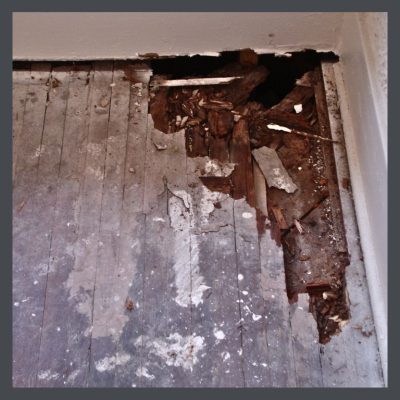 Wood flooring is a major, character-defining feature in a bungalow & I vigorously encourage their restoration. However sometimes, they are so worn or damaged that it requires installing new wood flooring in your old house to provide a surface that provides sufficient safety & functionality. Fortunately, more often, they require only patching. This article is about the types of materials available which you would choose for patching or replacement.
Wood flooring is a major, character-defining feature in a bungalow & I vigorously encourage their restoration. However sometimes, they are so worn or damaged that it requires installing new wood flooring in your old house to provide a surface that provides sufficient safety & functionality. Fortunately, more often, they require only patching. This article is about the types of materials available which you would choose for patching or replacement.
One of my followers is preparing to replace her floors so I have been answering many questions for her, which is what prompted this article, putting together all the pieces.
Here are the basics, in more detail than I have provided in the glossary. I will link to the wood flooring glossary when using terms that are covered there. It’s a really long article, so stay with me!
I write for you (& for my younger self, desperate to learn all these things to do right by my house) so any questions that you might have, I want them! If I have been unclear or omitted needed information, please let me know!
THE BASICS OF INSTALLING NEW WOOD FLOORING IN YOUR OLD HOUSE
Wood flooring products are referred to as tongue & groove, or T&G because protruding tongue is cut in one side of the board & a groove is cut in the other at the mill, allowing the pieces to be fit together closely when installed. This was done so nails could be hammered into the tongue & hidden from view by the groove. Before the advent of T & G flooring, boards were nailed from the top and these nails were visible.
In unfinished wood, the area above the groove, the top or wear layer, is ¼” thick. If you purchase salvaged wood, you need to ensure that the top layer is at least 3/16″ thick.
HARD & SOFT WOODS
Woods are categorized as hard or soft woods. The hardness of a wood is determined by its ability to resist indentation. Hardwood comes from broad leaved trees such as oak, ash, cherry, maple & poplar. Softwoods come from conifers, such as pine, fir, or spruce. To learn more about the hardness of woods, read this article by the National Wood Flooring Association here. You’ll see that there is great variation amongst the resistance of each category.
In many bungalows more than one species is used, either in patterns or in different rooms. Often the public areas were a more expensive hardwood & the private were a locally sourced softwood.
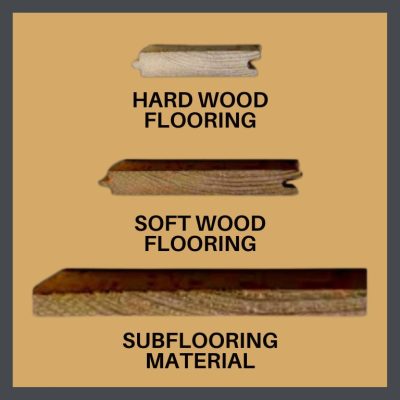 The wood found in most bungalows is called strip flooring. Hardwoods are mostly 2 ¼” wide by ¾” thick. Softwoods can be wider, usually 3 1/4″.
The wood found in most bungalows is called strip flooring. Hardwoods are mostly 2 ¼” wide by ¾” thick. Softwoods can be wider, usually 3 1/4″.
LENGTHS OF FLOORING
Wood can be purchased in different lengths, with each gradation being more costly. Often, the boards used in public areas were longer than those used in private areas. However, in homes which have hardwood flooring such as oak in the public areas, with pine or fir (softwoods) floors in the private areas, the softwood floors were always longer in length than those of hardwood floors.
ORIGINAL
Hardwoods: 2′-8′, with an average of 4′.
Softwoods: 6′- room length, with the max at 16.’ It was common that many pieces would be 10′-15′ long.
TODAY
Hardwood solid, unfinished- (standard) 9″-7′ with an average of 2 1/2′ to 2 3/4″ wide. You can get specially milled flooring that is longer for more $$$.
Hardwood engineered, unfinished- better brands offer 1′ to 7′. 2 1/4″ width may not be available unless you have it custom milled at a much higher price.
Hardwood prefinished, solid today- varies between 9″-7′ for better products.
Hardwood prefinished, engineered today- no data. Varies greatly by manufacturer.
HOW WOOD IS CUT FROM THE LOG DETERMINES ITS APPEARANCE & STABILITY
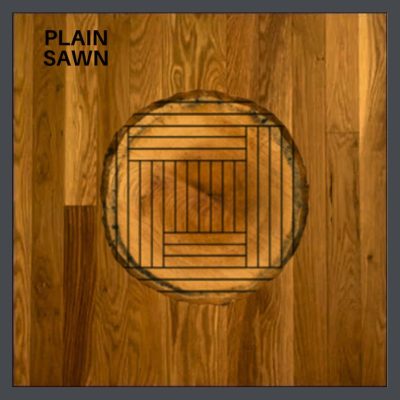 PLAIN SAWN
PLAIN SAWN
This cut utilizes the whole log, with the smallest amount of waste, making it the least costly of all the grain patterns. It results in a large, course, looping grain pattern. Plain sawn wood is less dimensionally stable (The degree with which wood shrinks & swells with changing moisture content) than quarter sawn or rift sawn so will tend to expand & contract more across the width of the boards than quarter sawn lumber.
Should you need to replace flooring in your house, I often recommend that oak be used because it is both reasonably hard and traditionally used. I suggest that this cut be chosen for the private areas because though it lacks the excitement of quarter sawn, it is still a workhorse.
Should you not be able to access quarter sawn or reclaimed, this is a fine type of oak to use in your public areas with all the beautiful rugs of the Arts & Crafts era. Unless you are a museum, your honoring the natural materials of the Movement counts with me.
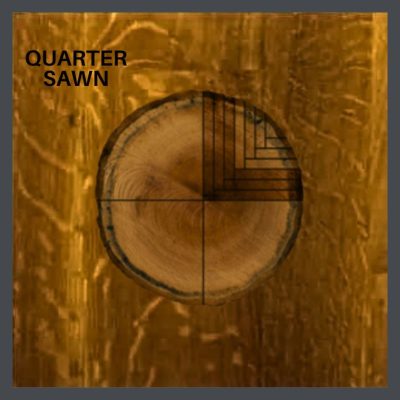 QUARTER SAWN
QUARTER SAWN
This is the wood of the Arts & Crafts Movement. When you gasp at the beauty of a Stickley piece, much of your awe & admiration are your reactions to the beautiful flecked graining, the Tiger Oak wood.
To produce the intense flame pattern, each log is sawed at a radial angle into four quarters. Then each quarter is cut along the center angles, near the center of the tree. (To better understand tree anatomy, read this article.) The wood from this cut twists & cups less than plainsawn, making for a more stable floor. It also wears more evenly under traffic.
Quarter sawn is more costly than plain sawn because it wastes more wood & is also more difficult to cut. I recommend its use in public areas where you want to impress your guests!
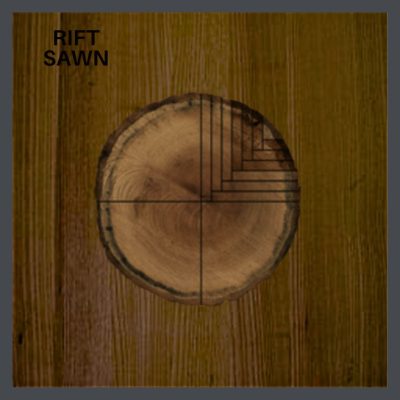 RIFT SAWN
RIFT SAWN
Rift sawing is similar to quarter sawing, with many of the same advantages. The way that it is cut accentuates the vertical grain but minimizes the tiger stripe effect found in quarter sawn oak.
Also a pricey option, it mixes beautifully with quarter sawn in a public area. I think that a floor of all quarter sawn looks whiskery! Rift sawn flooring was not used in older homes by itself, but was usually mixed with quarter sawn in a cut sold as “rift & quarter sawn” flooring. Today, standard milled oak flooring is sold as rift & quarter sawn as a mixed grade. You get more rift, usually 70% of the bundle, than quartered boards. This is much more economical than purchasing, from a specialty mill, all quartered or all rift cut oak. Place the boards strategically so that it is varied throughout the floor.
GRADES OF LUMBER USED IN WOOD FLOORING
There are more grades, but none that are appropriate for use in a bungalow. Some of the omitted grades are lacking in character (considered imperfections) & lose the look of real wood & some have too much character & appear too rustic.
Here’s straight from the big guys, the National Wood Flooring Association:
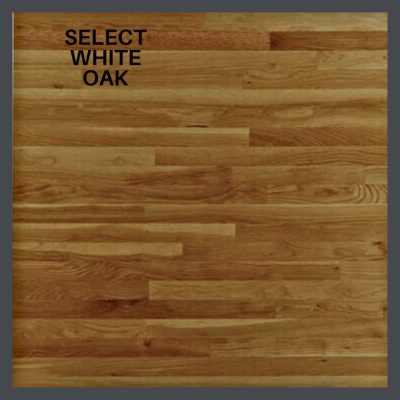 SELECT OAK
SELECT OAK
Contains all the variations in coloration produced by the contrasting differences of heartwood & sapwood. Also included are minimal character marks, such as small knots, worm holes, & mineral streaks, as well as slightly open characters.
The combination creates a floor where the light sapwood & dark heartwood are combined with small characters & other small color interruptions.
Should you be unable to access reclaimed wood or quarter sawn, in newly harvested wood, this grade, in plain sawn, is a good choice for your public areas. Arts & Crafts patterned rugs are perfect accents for bungalows & this grade of flooring will look beautiful with them in your home. Honest. View some beautiful ones I have collected for you on my Pinterest board, here.
#1 COMMON OAK
A flooring product characterized by greater color variation than Select, that also contains prominent characters (with size limits) such as knots, open checks, worm holes, along with machining & drying variations.
#1 Common is a tasteful floor where prominent variation is expected. I think it looks fine in private areas, but you need to make sure that the colors are well placed, so that the floor doesn’t look like a study in color-blocking! You can use the shorter, knottier pieces, or ones with more blemishes in your closets.
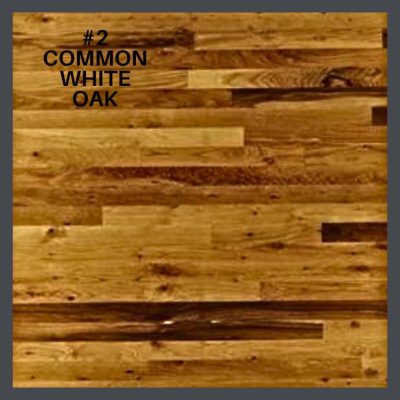 #2 COMMON OAK
#2 COMMON OAK
#2 Common may contain sound natural variations of the forest product & is suitable for homes, general utility use, or where character marks & contrasting appearance is desired.
I like this choice in finished attics because I like them to look like what they are! In unfinished products, this is a material that you can paint without feeling bad about it. And don’t try to hide the character marks. It’s an attic!
THE BEST CHOICE IN AN OLD HOUSE- RECLAIMED OR SALVAGED WOOD
This is your first choice. Reclaimed, old-growth wood is milled from lumber harvested from ancient forests that is either rescued as logs from the bottoms of rivers & milled into lumber for various uses, or is removed from old buildings & re-milled for other purposes. Sometimes old flooring is salvaged & employed again as flooring which often does not require milling. You can see some cool videos about it here.
Recycled wood is available in solid unfinished, solid prefinished & also in engineered, unfinished or prefinished.
Should your site finished (as opposed to factory finished) floor require patching, this is the type of wood that you will need to use, especially if your floors are old heart of pine. You can read about its properties & its value here.
TYPES OF WOOD PRODUCTS
UNFINISHED WOOD FLOORING
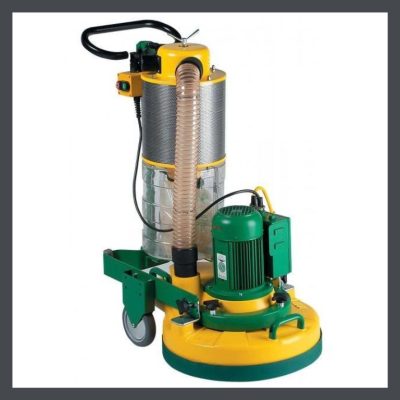 This is the type of wood that was installed in our old houses when they were built. It requires sanding & finishing on site after installation is completed. Today it is milled from newly harvested trees, generally grown on tree farms. It can also be milled from reclaimed material, or, salvaged as flooring from old buildings.
This is the type of wood that was installed in our old houses when they were built. It requires sanding & finishing on site after installation is completed. Today it is milled from newly harvested trees, generally grown on tree farms. It can also be milled from reclaimed material, or, salvaged as flooring from old buildings.
Unfinished wood flooring, either newly milled or reclaimed, is available in solid or engineered.
After unfinished wood is completely installed, it is sanded, sometimes stained, & then coated with a protective finish. This article explains many of the finish options available.
Unfinished flooring allows you to create a completely custom floor so that you can match or complement the other floors in your home.
PREFINISHED WOOD FLOORING
A prefinished floor is one on which the stain & finish (a clear, protective coating) are applied at the factory. There are many tough finishes available from oil penetrating finishes which provide a matte finish, natural look, to polyurethanes which coat the wood & are available in matte to high gloss. Most of the finishes you can use on a site finished floor are avail in prefinished. You can read about them here. You are going to want to choose one with a medium gloss which mimics wax or shellac. As far as choosing a sheen level, a matte floor shows dust, dirt & fur & a shiny one obscures the grain & shows scratches & dust, dirt & fur.
The factory/manufacturer applied finishes, especially products at the higher end, are very tough, & are more durable than those applied on the job to unfinished wood. Many prefinished products can be sanded at least once. If you do not have to match existing flooring, it can be a good option, with a few caveats.
Here’s where prefinished floors can have a drawback. In your old floor, after the raw, unfinished wood was laid, several passes were made over it with a sanding machine to fully level all sides of the boards where they join the next rows. This sanding is not done on a prefinished floor. The boards are sanded at the factory before the finish is applied. Consequently, there may be some differences in leveling from board to board. There are several ways in which manufacturers cut the wood at the factory (mill) to make the final floor appear flat.
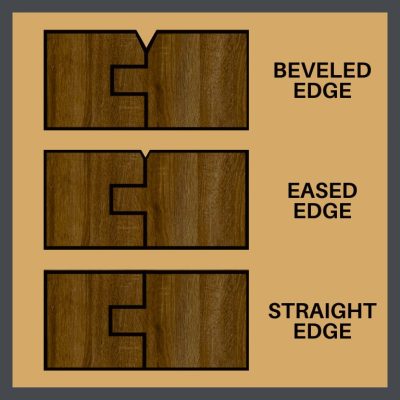 BEVELED EDGE
BEVELED EDGE
These products have a very distinctive groove in them.
EASED EDGE
This is the most common. Each board is just slightly beveled. Some manufacturers add an eased edge to both the length of the planks as well as the end joints. Even this small groove helps hide uneven plank heights. Eased edge is also called a micro-beveled edge.
SQUARE EDGE
The edges of all boards meet squarely creating a uniform, smooth surface that blends the floor together from board to board, giving it the same appearance as an old floor. High-end mills offer this option at a higher cost because each board must be cut with great precision. This floor will still not be as flat as a floor that has been sanded on site.
CONSTRUCTION CHOICES IN WOOD FLOORING
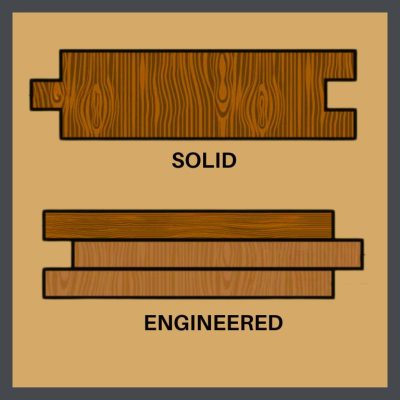 SOLID FLOORING
SOLID FLOORING
Your traditional floor, which you would find as the original flooring in your historic bungalow. This flooring is cut from one piece of wood. When you look at a piece of it from the side, you see no striations/layers.
ENGINEERED FLOORING
This type is created in layers that are glued together. The veneer on the top is called the wear layer & can be of varying thicknesses.
The wear layer of engineered floors can be from 1/32″ to 1/4″ (1 mm to 6 mm) thick, again, affecting the price point.
This method of construction increases the stability of the boards. Especially in high moisture areas or situations, I think it can be a good choice. The majority of the time, these products are prefinished & have the 3 above edging characteristics. Square edged prefinished engineered floors are uncommon & at a much higher price point than are beveled ones.
Engineered wood can also be sold as square edged unfinished, but is more expensive than most prefinished flooring. Usually the wear layer is at least 3 mm on these products. I like this product in humid climates.
WHAT IS VENEER?
Engineered hardwood flooring is built up using layers of plywood or a high density fiber board then on the top a layer of wood veneer, to create the look of real hardwood. Veneer is a thin layer of wood or other material for facing or inlaying wood. Veneer is made of a particular material that is applied to a different material in order to create a more desirable surface appearance than that of the basic material of the object.
SAWN FACE VENEER
The dry-sawn face method creates a thicker layer (4 mm) of veneer than the other methods. This method creates a veneer with an appearance that is identical to solid hardwood in color, grain, & character. (See cut & grain examples above.) This method produces the least amount of usable veneer so it is more costly than the other two methods below.
SLICED VENEER
Slice-cut is the second most common way to create a wood veneer. The finished wood presents a lovely face, like the sawn face above, but is in thinner layers (2mm or less) & is generally less pricey.
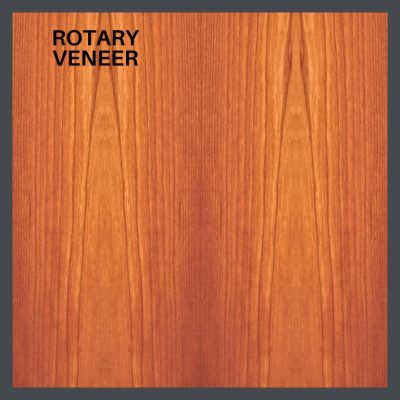 ROTARY PEELED VENEER
ROTARY PEELED VENEER
In this method, the log is put on a spit & peeled in a long, thin layer. The wood is then flattened which is damaging to its integrity & wearability. This cutting & flattening process produces an unnatural, repeating, unattractive grain pattern. It does create the maximum amount of product from the wood, so it is sold at the lowest price point.
That’s why there’s so much of it out there. I hate it! Be aware that, because of its low price, it is often chosen by flippers. If you see a floor that almost looks like wood, & is touted as being wood, this is likely what it is.
Engineered flooring has gotten a bit of a hit because the inferior products produced by this method. Engineered wood is a good, durable product & is quite suitable in a historic house- if- you choose the first method. I do not recommend the sliced veneer & do NOT choose rotary veneer flooring.
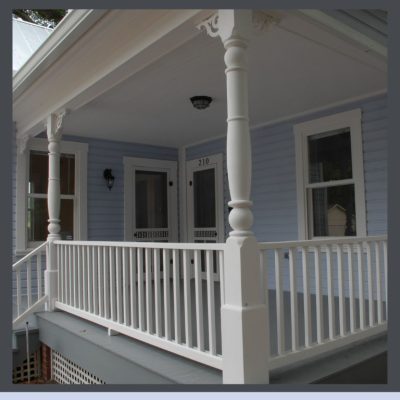 PORCH FLOORS IN BUNGALOWS
PORCH FLOORS IN BUNGALOWS
We replaced a covered porch deck on a 1907 Folk Victorian that we restored & used pressure treated, 3/4″ by 3 & 1/8″ wide, yellow, T & G pine which at least in Florida, is available in a pressure treated product.
Pressure treated wood must dry 30 days before it can be primed & painted. We painted the bottom of the boards before installation & the top after. You might be able to get pressure treated decking which has been kiln dried after it is treated, so the 30 days can be omitted. Sanding is required to give you a smooth level surface, just like with any wood floor.
Porch boards are subject to much wear & water. It is really important to make sure that they are slightly angled so that the water runs off. It’s also a good idea to have a large squeegee on a long handle so that you can dry them after a rain.
MY TOP CHOICES WHEN INSTALLING NEW WOOD FLOORING IN YOUR OLD HOUSE
In answer to the Good, Better, Best question of my follower:
BEST: 2 ¼” wide, reclaimed wood or salvaged old growth wood flooring, (with a 3/16” or thicker wear layer for 3/4″ T&G flooring, whether it be solid or engineered) of whatever species & grade was in your house originally. In any single house, there could have been more than one species, generally a pricier hardwood in the public areas & a less costly softwood (usually 3 1/4″ wide by 3/4″ thick) in the private. (This is the wood that you need for patching.)
Hire a qualified pro to sand & finish it. Reclaimed wood is $$$$$ & you don’t want to waste it.
BETTER: Select 2 ¼” wide, newly milled, farmed quarter sawn oak, either unfinished or prefinished (squared edged, please see above) solid or engineered with a thick veneer, for public areas. For private areas, 2 1/4” wide, in Select or #1 common oak. You do not want to use farmed softwoods. They are ridiculously soft.
If you want to finish it yourself, I recommend that you ensure that the equipment that you use is the latest & greatest & dust free, well maintained & calibrated. Then study these videos.
GOOD: A Select plainsawn wood floor that is either prefinished or unfinished, solid or engineered. Just no heavy bevels & no rotary veneer. (All are covered above.) Same instructions for sanding & finishing.
CAVEAT
Installing it too, or farming it out to a carpenter or handy friend, make sure that they & that they wear the correct PPE & if you are living in the house, or even visiting, please understand the materials that are being used wear it too. Read this!


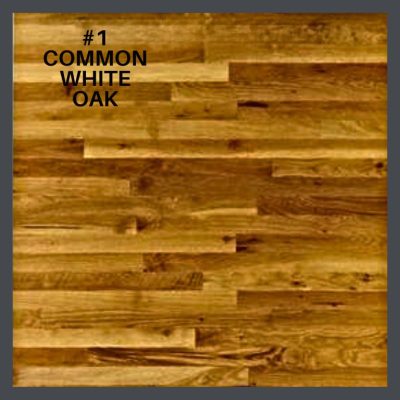

Thank you for covering every last little decision that has to be made! In my search, I also came across the decision to have your unfinished, solid wood planks sanded at the factory. I wonder how the site finishers that are professionals feel about this? As a homeowner, the idea of less dust is certainly appealing.
You have great questions!
I am fine with it, but sadly, I’m not the one finishing your floors! With a good dustless system, there should be little to no dust. If your concern is cost, it’s going to depend on the price of the product & how much the flooring pro charges.